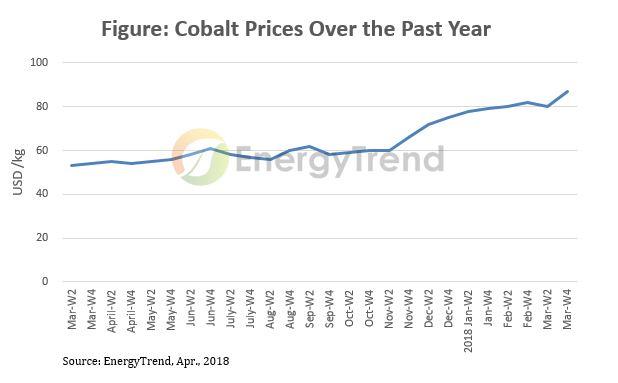EnergyTrend points to short-term capital speculation and high supplier concentration as the main cause for the rise of raw material costs, and says this ‘concentrated industry structure’ may proceed to push prices in the long-term.
The data reveals that the soaring costs of raw material will be reflected in prices of lithium batteries and new energy vehicles quarter by quarter. With such heavy reliance resting on cobalt, the battery industry will continue its search to find an alternative material.
According to Duff Lu, senior research manager of EnergyTrend, the price of cobalt has been a focus of market. The use of cobalt provides battery makers with the easiest way to increase energy density before the new generation materials become matured.
The price of cobalt metal has hits new highs, Lu adds, from $32/kg in early 2017 to $75/kg at the year end – an annual growth of 114%. In Q1 2018, the price went up by another 26% quarterly, reaching $95/kg. Lu continues that the rising price will bring more challenges to the development of the new energy vehicle industry.
"The change in cobalt metal prices is mainly influenced by short-term speculation in the market", explains Lu. The prices are mainly decided by the supply side rather than based on supply and demand. Many second-tier makers of battery cells and battery anode material have also been hit hard by the fluctuation of raw material prices. Their cost in raw material purchase turned out to be higher than that of the first-tier manufacturers. Battery system makers and branded makers also rely on first-tier manufacturers for cost considerations, resulting in less diversified supply and less healthy competition in the market.

However, EnergyTrend says in the battery cells of IT products, the proportion of cobalt is less than 5%, meaning the prices of cobalt will have limited impact on consumer electronics.
To reduce cost pressure, battery makers are expected to lower the percentage of cobalt in current lithium nickel manganese cobalt oxide (NMC) batteries, EnergyTrend reveals.
Lu says that battery system makers and branded makers will accelerate the development of new generation material and alternatives to reduce the restriction brought by raw materials. Along with developing products with high ratio of nickel, Lu continues, battery makers will also accelerate the mass production of lithium-ion batteries that use silicon oxide as cathode materials.
These two approaches focus on increasing energy density, while another solution based on blended polymer can effectively reduce costs, the report explains. In the blended polymer solution, NMC and lithium cobalt oxide (LCO) are blended in the anode materials of lithium-ion batteries. Although the energy density is lowered by approximately 20%, this, the data reveals, will still be the direction of development for companies, due to the low costs.
Major battery cell suppliers like Samsung SDI, LG Chem, and Lishen have proposed blended polymer solutions in which the portion of NMC is higher than 20%. However, swelling of the cell remains a problem for the application of NMC materials in polymer batteries. Therefore, the industry has not yet accumulated complete research and development experience, EnergyTrend says.
There will be a chance to see a small amount of blended polymer batteries in the market in the second half of 2018, it adds. But, if the cobalt price declines rapidly in the future, it will need further observation to find out whether the development of blended polymer solutions is valuable for the market.













